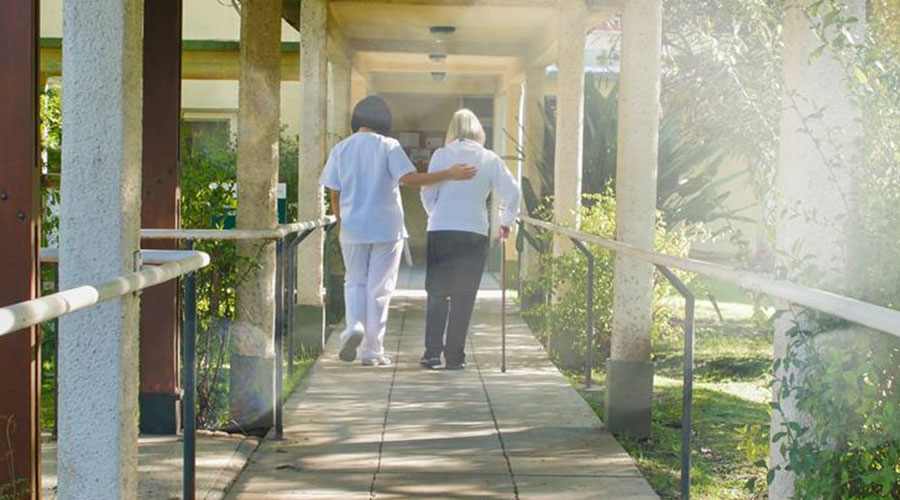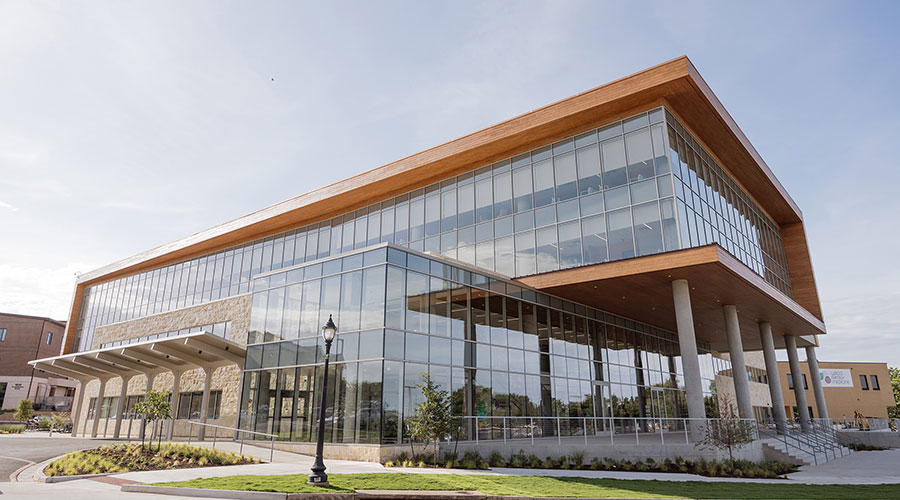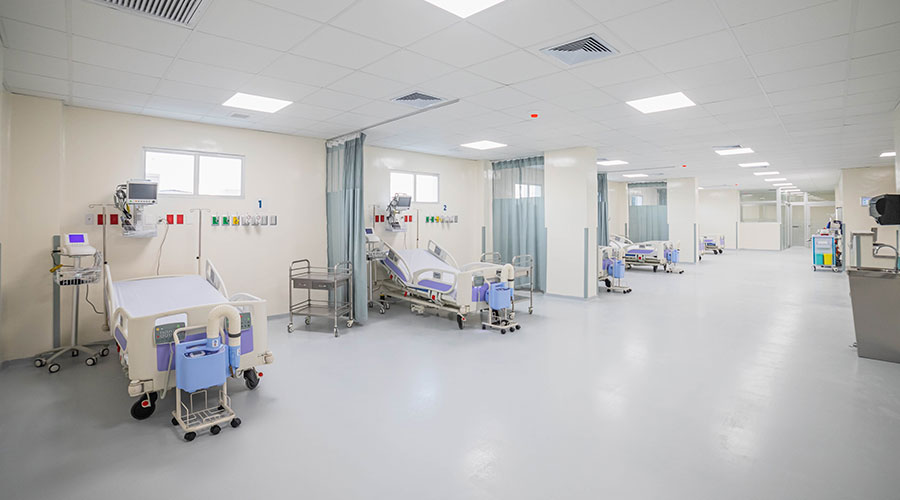The golden years just became a little brighter at Baltimore’s Glen Meadow Retirement Community thanks to the recent completion of a massive solar panel installation.
The 1.2-megawatt solar array consists of 4,150 panels and will generate 1.5 million kilowatt hours of energy annually – making it one of the largest such projects in the Baltimore metro area to date.
The installation is projected to provide $700,000 in energy cost savings over the course of the 20-year power purchase agreement at a fixed, low-cost rate while reducing the demand for electricity created by coal and natural gas by 1.5 million kilowatt hours per year.
The project is the work of ABM, which provided the engineering, procurement, construction and commissioning of the solar array on behalf of Washington Gas Energy Systems and Sol Systems—the companies that own it (Washington Gas Energy Systems) and are responsible for its solar financing (Sol Systems). In addition to being responsible for construction, ABM will also maintain the solar array on behalf of Washington Gas Energy Systems.
It’s a win-win for Glen Meadows, which is a subsidiary of Presbyterian Senior Living (PSL). In addition to the unprecedented project’s environmental impact, research shows that similar installations greatly improve both community and resident satisfaction.
“Residents love the idea of green,” says PSL Chief Financial Officer Jeff Davis. “They think it’s phenomenal. Once we shared the idea, the residents were almost pushing us to get it done.”
While Glen Meadows is set on 480 acres in Baltimore County, the community actively utilized a mere 30 acres of that land, Davis says. Consequently, the space and situation of the panels have been agreeable to both the community and the surrounding neighbors because they are set back and not visible from the adjacent roadways.
“Sometimes there can be struggles with community for this kind of project but these are not visible from the road or general public,” Davis says. “It gave us a great place to absorb the sun.”
PSL only wishes they had implemented the project earlier. At the height of the recent economic downturn, Glen Meadows experienced a 30 percent reduction in ‘move-in’ clients, which led Davis to look for cost-cutting measures anywhere possible.
After being forced to lay off 130 of the senior living provider’s nearly 3,000 employees nationwide, Davis knew he needed to find a creative alternative to cutting additional labor.
One day, while channel surfing at home, Davis happened upon a television documentary discussing the world’s future energy challenges. Among other eye-opening facts, he learned that energy consumption in the U.S. is three to ten times higher than in other countries. It was the ‘a-ha moment’ Davis had been waiting for and spawned the idea to create a ‘green’ committee at PSL.
He quickly received approval from PSL CEO Steve Proctor. The group included himself, the corporate director of plant operations and construction, an energy consultant and a building systems engineer. One of the initial ideas of the committee was to utilize solar energy at certain sites.
In late 2013, PSL partnered with ABM to implement the solar array project at Glen Meadows. Needless to say, ABM was excited to play such an integral role in the groundbreaking utility-scale solar development project. In the last decade, the facility services company had made significant investments to increase its expertise in the development of renewable energy as a solution to reduce owning and operating costs and increase energy efficiency for its clients. When called upon, they were ready with the following five-point plan:
1. Re-design and value engineer the solar array to bring costs down and increase power production.
2. Devise a financial solution to make the project feasible—including tax equity and Solar Renewable Energy Certificate (SREC) off-takes. An SREC is a type of clean energy credit in the form of a tradable certificate useful for demonstrating compliance in state Renewable Portfolio Standard markets.
3. Provide bankable Engineering, Procurement and Construction (EPC) services
4. Install the solar array.
5. Provide ongoing operations and maintenance.
Needless to say, the results speak for themselves and all involved agree the project has been a tremendous win. However, the success of the Glen Meadows solar array remains somewhat bittersweet for Davis.
“Quite frankly, if we had started the green programs we have initiated in the past few years much sooner,” Davis says. “I believe the cost savings would have helped us to get through a period of lower revenue without letting people go.”
Of course, hindsight is always 20/20. The more important fact is that since the PSL committee started its work three years ago it has netted annual savings on several projects, including the Glen Meadows solar array, of nearly $1 million dollars and they helped fund the additional projects with stimulus money, low interest energy loans and cash flow—rather than PSL’s own capital budget.
Energy retrofitting is such a good investment, Davis says, that he has recommended to his CEO and board that PSL set aside 20 percent of its annual $13 million capital budget and part of its $80 million endowment just for this purpose.
“We’re picking up the easy dollars from deploying sustainable energy in new construction,” says Davis. “Now we need to go after the more difficult and expensive retrofitting.”
Yet the retrofitting model is unquestionably beneficial to non-profit senior living providers like PSL because of their business model. “We have done business in some locations for 100 years,” Davis says. “The concept of long-term sustainability is ever more important and a huge value-add in terms of community and resident satisfaction.”
Interestingly, environmental stewardship has deep roots in PSL’s history. Responsible stewardship of land dates back to the beginnings of Presbyterian Homes with the ownership of the Parker Farm in Newville, Pa., their first location. Early documents from the archives show efforts at crop rotation, and planting of trees that have matured to create PSL’s lush Green Ridge Village campus.
“Energy conservation has been an area of focus that began with the desire to control costs and expanded to a concern for energy consumption that has become one of the markers of good citizenship as an organization,” PSL’s website says. “As the scope of our ministry has grown to include thousands of acres of land and thousands of people served annually, our focus on environmental stewardship has intensified.”
Projects like the Glen Meadows solar array are also good for the state. Solar power accounts for only a small percentage of Maryland electricity generation, but the number of arrays in the state are expanding quickly. Commercial-scale projects such as the Glen Meadows array have grown from less than 1.5 megawatts in total five years ago to more than 60 megawatts now, according to the Maryland Energy Administration.
What’s more, due to Maryland’s green energy mandates, the project helps reach statewide alternative energy targets that are commonly supported through tax credits and depreciation.
As a result, thanks to sustainability visionaries like PSL’s Jeff Davis and experienced facility services companies like ABM, the future is looking a lot brighter for not just an industry, but the country as a whole.
O’Shea is a vice president of energy at ABM Government Services.

 Designing Hospitals for Wellness
Designing Hospitals for Wellness Baptist Health Announces New Cancer Care Center in Key West
Baptist Health Announces New Cancer Care Center in Key West Waco Family Medicine Achieves Savings and Bold Design with Wood Selections
Waco Family Medicine Achieves Savings and Bold Design with Wood Selections Alleged Ransomware Administrator Extradited from South Korea
Alleged Ransomware Administrator Extradited from South Korea Design Plans Unveiled for New Intermountain St. Vincent Regional Hospital
Design Plans Unveiled for New Intermountain St. Vincent Regional Hospital